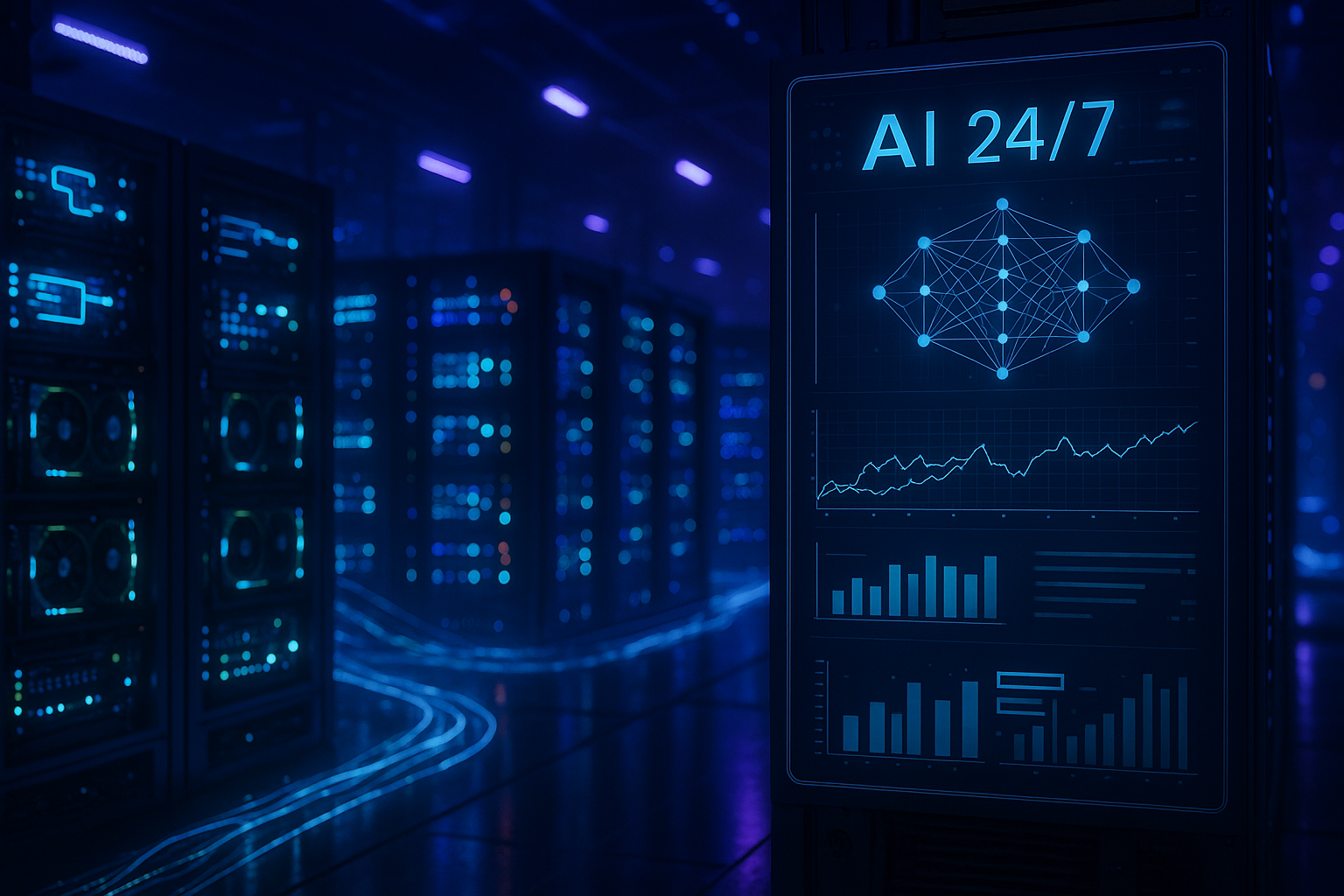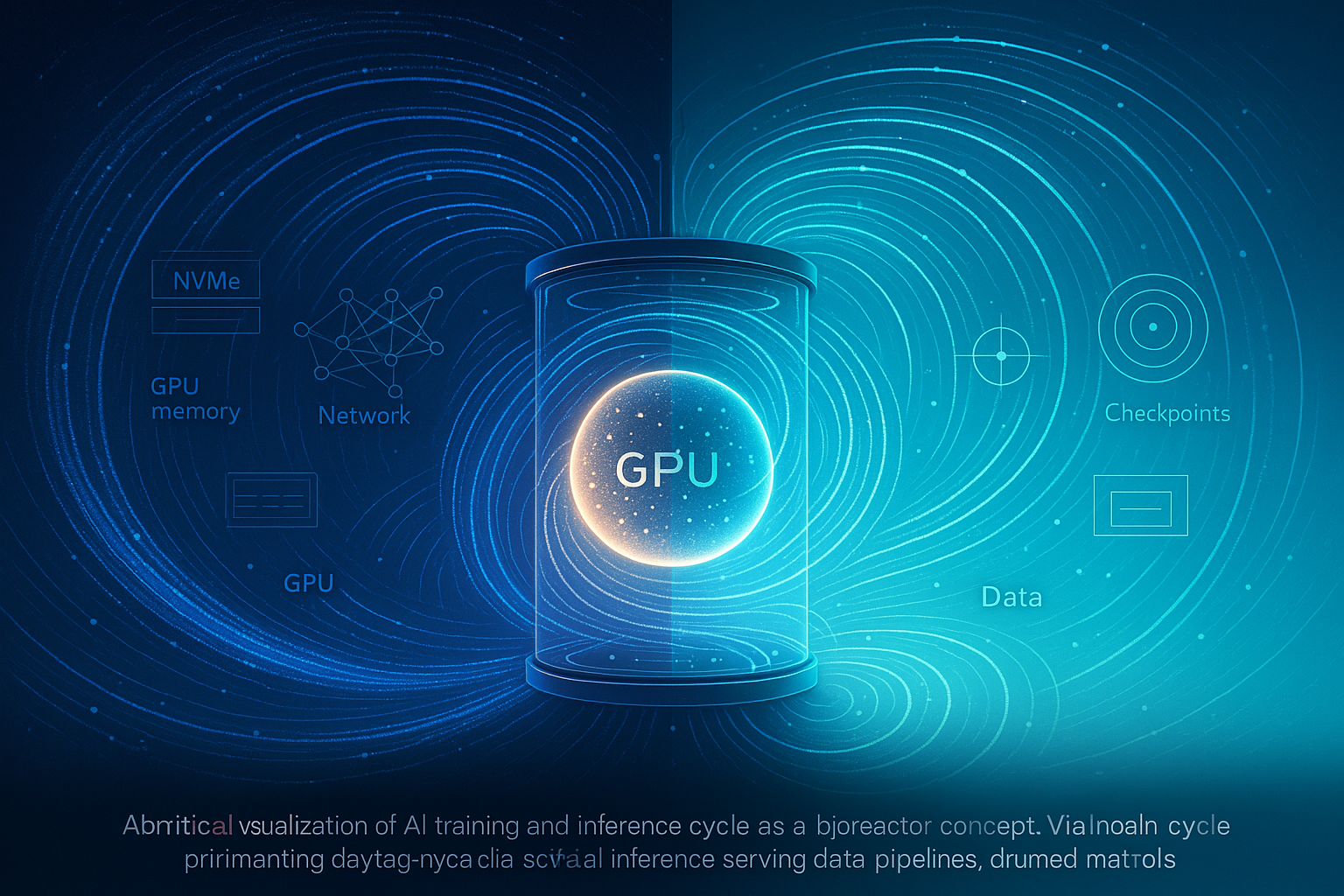What it is
“The Labs That Never Sleep” isn’t a slogan. It’s the operating model of modern AI teams: data ingestion and cleaning → pretraining/fine‑tuning → offline validation → packaging artifacts → rolling out inference → telemetry feeding back into the pipeline. There are no pauses in this cycle: – At night, heavy training runs progress faster- network pipes are freer, contention is lower. – Day and night, inference endpoints face peaks: LLM chat, summarization, semantic search, recommendations, support copilots. – Datasets grow in real time: request logs, clicks, ratings, prompts, images/audio/video, sensor feeds.
The core principle is predictability and reproducibility. When your LLM or multimodal stack lives by tight P95/P99 latency SLOs and your fine‑tunes cost dozens of GPU‑hours, noisy virtualization is a tax you can’t afford. Sporadic throttling, PCIe/memory oversubscription, jittery I/O, unstable NUMA affinity- all of that turns training into a coin toss and production into a roller coaster. That is why the heart of the lab is clean bare metal with strong GPUs, fast networking, and NVMe.
Think of it as a bioreactor: – Nutrient medium – your data. Quality dictates convergence speed and behavior. – Temperature and oxygen – cooling and bandwidth (NVLink/PCIe, RDMA/InfiniBand, NVMe IOPS). – Sterility – hardware‑level isolation (no “noisy neighbors”), clean images, controlled driver versions. – Sensors and valves – monitoring, alerting, autoscaling, and incident runbooks.
Real products grow this way: not by hackathon leaps, but in a 24/7 rhythm where each iteration is a continuation of the last- and the infrastructure gets out of the way.

How it works
1) Data pipeline and preparation
Event streams from apps, CRMs, logs, sessions, images, and audio land in object storage and a staging layer. Formats: Parquet/Arrow. Layouts: time/version partitioning. Retention: hot/warm/cold shard sets. Preprocessing runs on local NVMe (for intermediates) and parallelizes with Spark/Ray/Dask. The choke points are: – I/O and IOPS: SATA slows ETL; NVMe RAID enables parallel access to sharded samples. – Networking: 25G is the practical floor; 100G is comfortable for 1–10 TB working sets; RDMA/RoCE offloads CPU copies. – Cleaning/dedup: text tokenizers, VAD for audio, EXIF filters for images, PII scrubbers for privacy.
2) Night‑shift training (pretrain/fine‑tune)
At night the scheduler (Slurm or Kubernetes with NVIDIA GPU Operator) bundles GPU nodes into jobs. Checkpoints stay on NVMe. Mixed precision (FP16/FP8), ZeRO/FSDP, and FlashAttention push VRAM usage down. Gradient sync runs over NCCL on NVLink/PCIe and high‑speed fabrics. Key points: – GPU class and VRAM: 7–13B fine‑tunes like 48–80 GB VRAM; multimodal and 70B models require multi‑node or aggressive memory strategies. – Thermal regime: bare metal simplifies stable clocks- IPMI, fan curves, quality power/cooling. – Determinism: pin CUDA/cuDNN/driver versions, seeds, and compilers; run bench smoke tests before long epochs.
3) Day‑and‑night inference (online serving)
Users don’t care about averages- they feel P95/P99. Production stacks ship micro‑batching, speculative decoding, and quantization (INT8/FP8) on engines like TensorRT, Triton Inference Server, vLLM, ONNX Runtime. For RAG, you’ll add vector DBs, fast disks, and RAM caches. To cope with millions of calls: – Vertical + horizontal scaling: scale replicas by tokens/sec queue depth; split tokenization to high‑clock CPU cores; fix NUMA affinity. – Anycast + L7 balancing: multi‑region entry points stabilize path selection. – Hybrid train→serve: the same nodes fine‑tune at night and serve by day; keep weights/checkpoints local to avoid copies.
4) Feedback and continuous improvement
Production telemetry flows back into training: hot intents, domain blind spots, toxic/hallucinatory outliers, segment performance. You’ll schedule new fine‑tunes/DPO/RLAIF, refresh RAG indices, and retune hyperparameters. The lab truly breathes: users by day, evolution by night.
5) Observability, SRE, and security
- Metrics: GPU util/memory/temps, tokens/sec, TTFB, P95/P99, queue lengths, NCCL all‑reduce, network pps/Gbps, disk IOPS/latency.
- Tracing: span‑level traces across RAG chains (retrieval → re‑rank → generation) aligned with CPU/GPU profiles.
- Runbooks & DR: fast checkpoint restarts, fire drills, mock incidents.
- Security: private VLANs, encryption at rest/in transit, secret management, abuse prevention for public APIs. For EU markets (GDPR), enforce data deletion, minimization, and prompt/log retention policies.
Why it matters
Predictability = iteration speed
Teams win not by working longer, but by getting faster feedback loops. If training runs predictably and production meets its SLOs, each night yields measurable quality gains. Bare metal eliminates hypervisor jitter and “noisy neighbor” effects, delivering clean data paths and stable clocks- so each epoch takes roughly the same time, benchmarks stay comparable, and regressions are visible.
The cost of error scales with traffic
One power flap can cascade into thousands of timeouts. A missing checkpoint wastes a day. If your architecture sags during peaks, the business loses faith in AI features. You need: – redundancy in power and networking; – NVMe RAID and object backups for artifacts; – frequent checkpointing; – smart orchestration with priorities and preemption.
Determinism and compliance
In fine‑tuning and RLHF, determinism is not a luxury. It’s the backbone of experiment reproducibility and correct A/B decisions. It’s also how you align with privacy/security requirements: full control over OS/drivers/patches and data sovereignty are simpler on dedicated hardware.
Throughput is the lab’s oxygen
NVLink/PCIe, RDMA/InfiniBand, NVMe pools, page‑locked buffers- all reduce copies and GPU idling. The cleaner the data path, the higher the tokens/sec and the faster the convergence.
Economics of outcomes
Measure cost per epoch and cost per token, not “price per hour.” Bare metal is predictable, so you can plan utilization, avoid paying for virtual overhead, and drive higher GPU occupancy. Over months, TCO typically drops.
How to choose
1. GPUs and memory
- R&D, fast prototyping: RTX 4090 / RTX 6000 Ada – great price/perf, strong FP16/FP8, 24–48 GB VRAM.
- Heavy training & multi‑node: A100 80GB / H100 – NVLink, excellent scaling, modern precision support, mature drivers.
- Mixed train+serve: L40S – balanced tokens/sec and efficiency for serving with light fine‑tunes.
VRAM sizing sketch: Parameters × bytes/param (FP16/FP8/INT8) + activations (depth/batch) + KV cache (context × tokens). Keep a 10–20% margin for spikes.
2. CPU, NUMA, and RAM
In‑flight tokenization, batch planning, RAG retrieval, serialization, compression- all hit CPUs hard. Prefer: – high‑clock cores and large L3; – strict NUMA pinning for threads and interrupts; – 256–512 GB RAM per node for large contexts and RAG indices.
3. Storage
- Local NVMe RAID 1/10 for checkpoints and hot shards – minimal latency, maximal IOPS.
- Network storage (Ceph/Lustre/high‑grade NFS) for shared datasets and long‑term artifacts.
- Prioritize checkpoint ingest/egress speed, parallel access, and resilience.
4. Networking
- 25G is table‑stakes; 100G delivers comfort for multi‑node and fast ETL.
- RDMA/RoCE/InfiniBand when you need swift all‑reduce and micro‑latency.
- Private VLANs, Anycast/ECMP, L4/L7 load balancing.
5. Orchestration & MLOps
- Containers: Docker + NVIDIA Container Toolkit.
- Schedulers: Kubernetes (GPU Operator) for generality; Slurm for dense HPC.
- Serving: Triton, vLLM, TensorRT‑LLM, ONNX Runtime; micro‑batching and speculative decoding.
- Experiments/artifacts: MLflow/W&B; curated model/dataset registries.
- CI/CD: image builds, tokens/sec & P95 as CI tests, canary deployments.
6. Observability & SRE
- GPU/CPU/IO/network metrics, tokens/sec, TTFB, P95/P99, queue depth.
- Tracing RAG chains with correlation IDs.
- Alerts on epoch/inference speed degradation.
- Runbooks and regular DR drills.
7. Security & compliance
- Hardware‑level isolation, private VLANs, encryption at rest/in transit.
- Secret management, access control, audit trails.
- GDPR playbooks: data locality, PII removal, retention for logs/prompts.
8. Economics & planning
- Compare cost per epoch/token, not per hour.
- Schedule utilization: training at night, inference by day.
- Budget for network/storage- they often become the bottleneck.
Unihost as the solution
Unihost is the bioreactor for AI startups– hardware, networking, and operations assembled as one coherent system. Practically, you get:
Clean bare metal
Full control over OS, drivers, CUDA/ROCm, microcode, and NUMA. No oversubscription or noisy neighbors. Predictable clocks, stable I/O, reproducible benchmarks.
Modern GPUs and topology
RTX 4090/RTX 6000 Ada for R&D; L40S/A100/H100 for heavy jobs. NVLink support, high TDP cooling, and PCIe layouts that respect NCCL paths.
Fast NVMe arrays
RAID pools for checkpoints and “hot” datasets. Low latency, high IOPS, flexible capacity, and durability.
Networking built for AI loads
From 25G to 100G+ per node, private VLANs, options for RDMA/RoCE/InfiniBand. Patterns for Anycast and L7 load balancers across regions.
Ops for MLOps
We help with driver/CUDA/NVIDIA Toolkit setup. Kubernetes/Slurm, Triton/vLLM, profiling and benchmarking (tokens/sec, P95/P99), quantization and micro‑batching guidance.
Observability and control
IPMI/out‑of‑band, temperature/fan monitoring, degradation alerts, inference logging, dashboards, and optimization tips.
Security by default
Private VLANs, API shielding, DDoS filtering, key management, access control, and privacy‑minded defaults.
24/7 support
Our SREs don’t sleep either: migrations, checkpoint recovery, emergency releases, and fast incident response.
Bottom line: without stable bare metal there would be no GPT‑like magic. Unihost gives you the predictable medium; you iterate- we keep the oxygen and temperature.
A practical rollout guide for a never‑sleeping lab
A minimally viable layout (MVP)
- R&D pool: 2–4 nodes on RTX 4090/RTX 6000 Ada, local NVMe (RAID10) 4–8 TB, Docker + NVIDIA Toolkit.
- Training node(s): 1–2 nodes on L40S/A100 80GB, 100G fabric, Slurm or K8s GPU Operator.
- Inference front: 1–2 nodes on L40S/A100, Triton or vLLM, autoscaling on queue depth.
- Storage: object bucket + checkpoint snapshots; local NVMe for hot artifacts.
- Observability: base GPU/CPU/IO/network metrics, tokens/sec, P95/P99; alerts on queue growth and temps.
Growing into a production cluster
- Add multi‑node training with RDMA/InfiniBand, 100–200G fabrics, FSDP/ZeRO.
- Separate roles: R&D pool, dedicated training cluster, and multi‑region inference with Anycast.
- Introduce canaries and in‑prod profiling.
- Automate RAG index refresh, regulate cleaning, and PII deletion.
Common pitfalls- and how to avoid them
- Storage hotspots: fix with sharding, local NVMe, pre‑loading checkpoints.
- NCCL bottlenecks: fix topology, env tuning, and all‑reduce sizes.
- P99 cliffs in prod: watch queues, enable micro‑batching, split CPU tokenization, keep VRAM headroom.
- Wobbly benchmarks: pin driver/lib versions, control NUMA affinity, warm up and stabilize clocks.
Case studies
Case 1: E‑commerce chat assistant
Goal: bi‑lingual assistant across a 2M‑SKU catalog; peak hours 10:00–22:00. Solution: L40S + vLLM for inference, RAG indices in RAM with NVMe backing, micro‑batching and speculative decoding; night fine‑tunes on A100 80GB using fresh dialog data. Outcome: P95 160–220 ms for short answers, tokens/sec +28%, search conversion +12% in six weeks.
Case 2: Multimodal UGC moderation
Goal: 24/7 images/video/text moderation with holiday spikes. Solution: RTX 6000 Ada inference cluster, night training on A100; private VLANs and strict privacy policies. Outcome: false positives down 18%, stabilized P99, zero thermal‑related downtime over the quarter.
Case 3: Call analytics (ASR/TTS + LLM)
Goal: on‑prem‑friendly transcription and summarization for compliance. Solution: bare‑metal nodes with 4090 for ASR/TTS and L40S for LLM; local NVMe for temporary WAV/embeddings; DR replication. Outcome: 27% TCO reduction compared to the prior stack, report generation ×2 faster.
Performance tips
- Keep hot data near GPUs: hot shards on local NVMe; use page‑locked and pinned memory.
- Optimize model memory: FSDP/ZeRO, FlashAttention, INT8/FP8 quantization; profile VRAM spikes and keep headroom.
- Tune NCCL: topology‑aware layouts, env vars (NCCL_SOCKET_IFNAME, NCCL_IB_HCA, etc.), all‑reduce sizes.
- Checkpoint often: reduce RTO; automate snapshots.
- Benchmarks as tests: tokens/sec, TTFB, P95/P99, and cost/token belong in CI; deviations fail the build.
- Split roles when needed: offload tokenization/retrieval to CPU/aux nodes to free GPUs.
- Thermals are performance: engineer airflow; keep racks and rooms within sensible ranges.
Why now
The AI market is accelerating. Users expect instant responses. Teams that put infrastructure on rails iterate faster: nights produce training gains; mornings ship new checkpoints; days run A/Bs on real traffic. The right bare metal with thought‑through networking and storage turns that loop short and reliable. Those who cling to “demo‑mode” lose weeks fighting jitter and heat.

Conclusion
Never‑sleeping labs are built on mature engineering discipline, stable bare metal, and data hygiene. Without this bioreactor, GPT‑like magic collapses into chance.
Unihost provides that medium: modern GPUs, fast NVMe and networking, hardware‑level isolation, observability, and 24/7 support. Plug in your pipelines, launch training, roll out inference- and keep the iterations flowing.
Try Unihost servers – stable infrastructure for your projects.
Order a GPU server at Unihost and get the performance your AI deserves.